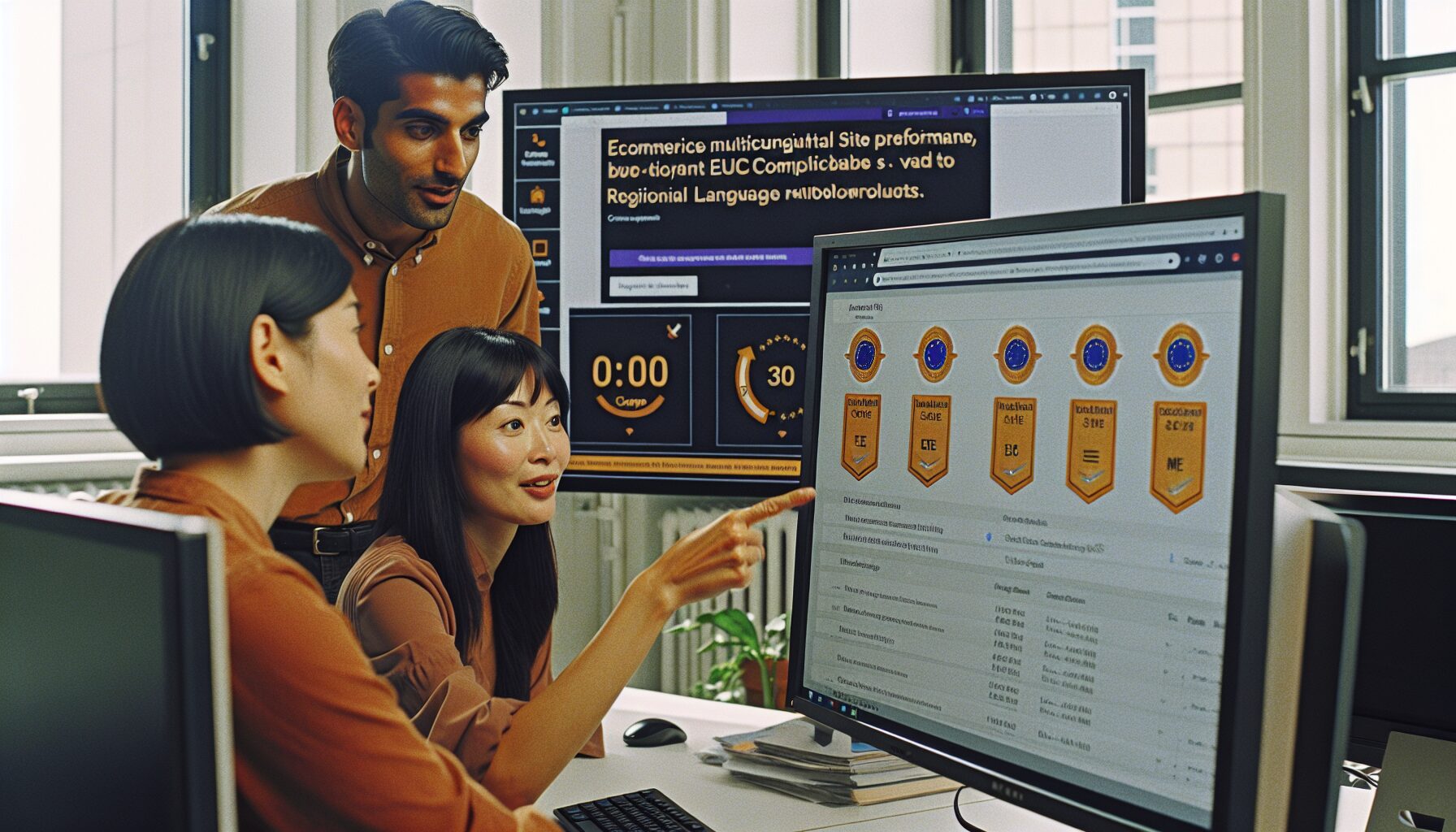About eldris
At Eldris, we automate SEO, multilingual site expansion, and EU compliance for brands scaling across Europe. Our AI-powered platform handles everything from content publishing to regulatory docs—so you don’t have to.
In This Article
- Multilingual website cloning ensures structural and branding consistency across languages.
- Costs range widely but depend on translation method, legal overlays, and media localisation.
- Manual translation provides quality, while automation offers speed—hybrid methods work best.
- Cloning requires compliance with region-specific laws like GDPR.
- Use TMS tools with memory, QA, and glossary capabilities for efficiency.
- Partner with experienced localisation services offering cultural, technical, and legal expertise.
What Is Multilingual Website Cloning?
Understanding the Concept
Multilingual website cloning refers to the replication of your existing website into different languages while maintaining its structural integrity, user interface, navigation, and interactive elements. Unlike plug-and-play translation widgets, it involves the strategic redevelopment of your content and design elements to ensure native-level fluency and cultural relevance. Cloning is not merely translating the text—it ensures a full-fidelity mirrored version of your website tailored to a specific linguistic audience.
The process entails copying the entire source code of your site and recreating it for each desired language. This often includes updates to SEO infrastructure, localisation of images and media assets, as well as adapting layout elements that may differ based on text direction or region-specific regulations. Importantly, multilingual website cloning ensures consistency across the brand experience.
Businesses engaging in multilingual website cloning gain advantages in field-specific regional search visibility, improved conversion rates, and stronger international brand perception. It goes beyond aesthetics and affects the core operations of how international users interact with digital platforms.

Why Clone Your Website for Multilingual Markets?
Benefits of Language Adaptation
Expanding into international markets without native-level localisation is a common misstep. Multilingual website cloning addresses this by allowing you to serve customers in their preferred language while maintaining brand consistency. The benefits include enhanced trust, increased engagement, and ultimately a higher conversion rate in non-English-speaking regions.
Users are far more likely to interact with and trust websites when content is presented in their native language. This is essential for user retention and satisfaction. Moreover, cloned websites enable better indexing by international search engines, ensuring your offerings are visible to your target demographic. It improves your SEO standing on platforms like Baidu, Yandex, or localised versions of Google.
Perhaps most significantly, fully cloned multilingual sites provide tailored experiences to culturally diverse populations. This results in a more intuitive user journey, which naturally boosts dwell time and revenue. Multilingual website cloning thus empowers businesses to align more closely with local lifestyles and expectations rather than offering a generic, catch-all solution.
How Much Does Multilingual Website Cloning Cost?
Pricing Models & Factors
The cost of multilingual website cloning varies significantly depending on website complexity, the number of target languages, and integration requirements. On average, businesses can expect to invest anywhere from £3,000 to £25,000 per language. For large-scale eCommerce platforms or dynamic sites with complex functionalities, the investment may be even greater.
Key pricing factors include the translation approach—automated or human—alongside localisation of media, cultural adaptation of design elements, search engine optimisation strategy per region, and legal compliance. Some cloning providers offer tiered pricing, where basic packages include translation only, while premium options encompass cultural localisation, local domain management, and audience testing.
Additional expenses can stem from third-party tools, plugin licensing, and ongoing maintenance. Cloning is not a one-off activity; it is an ongoing commitment to quality and performance in every market served. Thus, budget planning should include periodic auditing, localised SEO updates, and user feedback iteration. For further budgeting information, businesses can consult Learn more about Global Website Expansion and Localisation.
Timeframes: How Fast Can You Deploy?
Speed to Market vs. Quality
The time required for multilingual website cloning largely depends on content volume, the degree of localisation required, and technical architecture. Simple brochure sites might be duplicated within a few weeks. In contrast, enterprise-level platforms with hundreds of pages and complex backend logic may take several months.
A realistic timeline for a mid-sized site would be 6 to 10 weeks, covering language localisation, UI/UX adjustments, testing, and regulatory alignment. It’s crucial not to rush this process; speed often compromises localisation quality and can deter new users if the content feels artificial or “machine-like”.
Using cloning services or tools with built-in translation memory can reduce deployment times substantially. Still, human oversight remains critical to ensure linguistic accuracy, especially in technical, legal, or medical domains. Collaboration between developers, translators, SEO professionals, and legal advisors streamlines the cloning process without sacrificing quality.
Ensuring EU Compliance Through Cloning
Rules, Laws, and Integrations
With GDPR and broader ePrivacy regulations shaping digital interaction across the EU, compliance has become a critical aspect of multilingual website cloning. Cloned websites must respect cookie policies, data handling practices, and disclosure standards in local languages. Merely translating your cookie notice is insufficient—you need to align your backend data processing workflows per region.
Additionally, some EU countries have unique legal requirements regarding product labelling, customer rights, and accessibility standards. Your multilingual clones must reflect those differences to avoid penalties or user legal challenges. Integrating region-specific payment gateways, delivery mechanisms, and VAT calculations are also mandatory for eCommerce platforms targeting the EU.
Neglecting legal localisation not only risks fines but may invalidate your ability to trade in those regions. Hence, multilingual website cloning should involve legal review processes and include compliance modules. For guidance on compliance strategy, refer to resources such as Common pitfalls in building multilingual websites.
Best Practices for Success
Avoiding Common Cloning Mistakes
The most common pitfall in multilingual website cloning is over-reliance on automated translation tools without post-editing. Automated translations, while fast, often miss idiomatic language or cultural context, leading to user distrust or confusion. As a best practice, use automation to accelerate translation but employ native proofreaders to ensure authenticity.
Another frequent mistake is using a single-server instance hosting all language versions. This impairs SEO because it dilutes geo-targeting signals. It’s better to use subdomains or country-specific TLDs (e.g., .fr for France) to enhance search engine relevance. Technical SEO setup, including hreflang tags, sitemap segmentation, and canonical linking, is vital.
Lastly, failing to localise contact information, currencies, or even button placement based on language orientation can impact trust and usability. A robust multilingual cloning strategy considers these nuances. Additional practical tips are available through Read a related article.
Use Case: Shopify Store Expansion to the EU
Real-World Implementation
Consider a UK-based Shopify store aiming to reach French, German, and Dutch audiences. Through multilingual website cloning, the store replicates its interface for each language but adapts scrolling style for RTL (right-to-left), regional currencies, and local delivery options. Integration of local payment solutions like Sofort, Klarna, and Carte Bancaire increased checkout completion by over 40%.
The merchant employed native translators and market-specific imagery to prevent cultural mishaps. SEO structures were adjusted locally using keywords native to each market, and EU-mandated cookie consent policies were embedded per country. Hosting was diversified using local CDNs to optimise speed. As a result, bounce rates dropped, and organic discovery grew exponentially within 90 days.
This shows that with the right implementation strategy, multilingual website cloning can transform eCommerce operations across national borders. For ongoing platform localisation, they used Shopify EU website cloning use case to manage translation memory and performance tracking.
Choosing the Right Cloning Partner
Service Evaluation Checklist
When selecting a partner for multilingual website cloning, experience and localisation expertise are paramount. Begin by vetting their portfolio. Have they handled sites comparable in scale to yours? Demand case studies in your target languages or markets.
Ensure they offer dedicated project management across time zones. Ask about translation practices—do they rely solely on machines, or is human QA integral to their process? Confirm whether mobile responsiveness, analytic integration, and legal compliance fall within their services.
Finally, transparency in pricing is key. Seek detail on licensing, support costs, and post-launch service. A credible partner should provide scalability options and performance audits at defined intervals. Their systems must easily integrate with your CMS, CRM, and third-party tools to avoid organisational friction.
Automated vs. Manual Translation: Which Is Best?
Balancing Speed and Accuracy
Automated translation tools like Google Translate or DeepL offer speed and affordability. However, they risk mistranslating context, tone, and industry-specific terminology. Manual translation, although slower and costlier, ensures accuracy, cultural nuance, and emotional resonance—particularly in marketing and legal content.
The ideal approach combines both. Use automation to populate templates and static content before applying human editorial layers for refinement. This balances cost efficiency with linguistic authenticity. When operating in high-stakes industries like healthcare, finance, or law, prioritise manual efforts.
For dynamic websites with frequent updates, consider Translation Management Systems (TMS) with memory capabilities. This ensures consistency without constantly recreating content. Investing in hybrid localisation models is one of the most sustainable multilingual website cloning strategies.
Tools That Streamline Multilingual Cloning
Features to Look For
Effective multilingual website cloning requires comprehensive toolkits. Look for platforms that provide side-by-side translation previews, workflow management dashboards, and real-time QA features. Integrated TMS with glossary storage and translation memory will drastically reduce future costs and inconsistencies.
Equally, tools offering automatic localisation of images, video captions, and PDF downloads help ensure consistency across all media. Browser-based version control and rollback functions are essential for tracking localisation changes over time. Dynamic content synchronisation and AI-assisted QA testing can drastically improve roll-out speed.
Some popular solutions also feature analytics to measure bounce rates or engagement metrics per language version. These insights help refine your localisation strategy over time. Choose tools that complement your CMS and offer robust API connectors for custom workflows.
“Multilingual website cloning allows brands to speak the language of success—in every sense. It’s not just about translation, it’s about inclusion.”
Final Takeaways: Ready to Clone and Launch
Global expansion requires more than translating a few paragraphs. Multilingual website cloning is an intensive, strategic initiative that preserves your site’s functionality, ensures legal compliance, and resonates with diverse users. From costs and toolkits to compliance and localisation depth, each consideration shapes your international success narrative.
With the right strategic partner and tools, your cloned websites will perform not just technically—but culturally and commercially. Now is the time to prepare your brand for multilingual excellence. Whether you’re expanding into the EU or the wider world, multilingual website cloning is your passport to borderless growth.
Great guide on multilingual-website-cloning-what-to-expect-and-cost – Community Feedback
What should I expect from a multilingual website cloning service?
Expect rapid replication of your site in multiple languages, consistent brand experience, improved SEO, and faster EU market entry without technical headaches.
How is the pricing of multilingual website cloning structured?
Pricing typically depends on site size, language volume, and required compliance. Platforms like Eldris provide transparent packages suited to ecommerce growth.
Does website cloning include compliance with EU regulations?
Many services, such as Eldris, offer EU compliance integration, ensuring legal readiness alongside seamless content and language adaptation.








